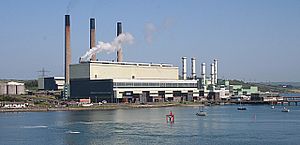Ballylumford Power Station
| Ballylumford Power Station | |
|---|---|
 The two power stations as viewed from the Whiteabbey to Larne Railway Line. | |
 | |
| Country | Northern Ireland, UK |
| Coordinates | 54°50′42″N 5°47′13″W / 54.845°N 5.787°W |
| Status | Operational |
| Commission date | 1943 |
| Operator | The AES Corporation |
| Thermal power station | |
| Primary fuel | Natural gas |
| Power generation | |
| Nameplate capacity |
|
| External links | |
| Website | www |
| Commons | Related media on Commons |
Irish grid reference: D4201 | |
Ballylumford power station is a natural-gas-fired power station in County Antrim, Northern Ireland, UK. With its main plant generating 600 megawatts of electricity, it is Northern Ireland's largest power station and provides half of the province's power.[1] Overall the station produces 1316MW. The plant is located at the tip of the Islandmagee peninsula, which separates Larne Lough from the Irish Sea. The lough is a Site of Special Scientific Interest. The 3 chimneys of the power station are 126 metres tall[citation needed]. East of the station is the static inverter plant of HVDC Moyle, a power cable connecting the system to Great Britain.
History
The first power station built at the site was started in 1943. The "A" station was powered by coal and operated until 1974, when the "B" station was completed.
The station was a key factor in the 1974 Ulster Workers' Council strike. Supplying all of Belfast and most of the eastern half of the country, Northern Ireland was effectively brought to a standstill when the mainly Protestant workers of the plant were persuaded to join the strike. The closure of the plant together with the wider strike resulted in the collapse of the Sunningdale Agreement.[2]
In 1991 the nationalised power company, Northern Ireland Electricity, was incorporated as a government owned public limited company. In 1992 the four power stations at Belfast Harbour, Ballylumford, Derry (Coolkeeragh) and Carrickfergus (Kilroot) were demerged and sold. In 1993 the remainder of NIE (transmission, supply and retail businesses) was privatised as Northern Ireland Electricity plc.
In 1992 the supply of electricity in Northern Ireland was privatised. As a result, Northern Ireland Electricity sold the Ballylumford site to its present owners, Premier Power Ltd, a subsidiary of British Gas. A condition of the sale was that the plant must be converted from heavy oil to gas-fired. British Gas formed Premier Transco Ltd. to build a submarine interconnector, the Scotland-Northern Ireland pipeline (SNIP), a 135 km pipe (40.4 km under sea) with a diameter of 0.61 m. Construction lasted three years (1994-1996) and was completed on time and on budget. Ballylumford converted to natural gas in 1996. To take advantage of this investment a licence was tendered to provide natural gas to Belfast, a tender which British Gas won through its subsidiary Phoenix Natural Gas.

In 2000 work began on the site's newest facility, a combined cycle gas turbine (CCGT), which has greatly increased efficiency and reduced pollution.[3]
The new power block, called "C" Station entered into commercial operation in 2003 and comprises steam turbines and gas turbines that can operate both in open cycle and in combined cycle. The gas turbines burn natural gas as the primary fuel but can also operate on low sulphur distillate liquid fuel if the gas fuel supply is interrupted. The electricity is generated at 15 and 18kV medium voltage and is increased to a higher 275/110kV level by step-up transformers to match the Northern Ireland Electricity (NIE) transmission system requirements. This high-voltage electricity is transferred by underground cables to existing outgoing feeder connections in an adjacent NIE switch house and then through the transmission system to the electricity users.
In 2010 the American-owned AES Corporation entered into an agreement with BG Energy Holdings to acquire Premier Power Ltd.[4] for £99m and are the power station's current owners.

Acquisition by AES Corporation
On 12 August 2010 the AES Corporation announced that its subsidiary, AES Ballylumford Holdings Limited, had acquired Premier Power Limited (PPL) through an all-cash transaction for £102 million (approximately $160 million), which included purchase price and working capital adjustment. The transaction was announced on 2 July 2010, and was subject to licence consents from the Northern Ireland Authority for Utility Regulation and the Northern Ireland Department of Enterprise, Trade and Investment.[5]
2018
In January 2018, Kilroot's failure to win a new contract under the Single Electricity Market threatened its closure by May. Ballylumford was also affected, with the B station likely to close with the potential loss of 30 jobs.[6]
See also
References
- ^ DETI
- ^ CAIN
- ^ NICS
- ^ "Archived copy". Archived from the original on 2011-07-26. Retrieved 2011-06-06.
{{cite web}}: Unknown parameter|deadurl=ignored (|url-status=suggested) (help)CS1 maint: archived copy as title (link) - ^ Poole, Amanda (2010-08-13). "Ballylumford snapped up for £102m". The Belfast Telegraph. Retrieved 2010-08-29.
- ^ John Campbell (26 January 2018). "Kilroot power station faces shutdown with loss of 240 jobs". BBC News Online.
